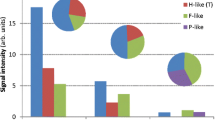Abstract
Complexation between Hg(II) and dissolved organic matter (DOM) collected from streams in Ontario, Canada, was studied using three-dimensional excitation emission matrix (3DEEM) fluorescence spectroscopy. The results show that DOM reacted with Hg(II) rapidly, and the complexation reached pseudo-equilibrium within 20 s. Maximum excitation/emission (Ex/Em) wavelengths shifted towards the longer wavelengths, indicating that DOM structure changed during its interaction with Hg(II). Using fluorescence quenching titrations, complexing parameters, conditional stability constants and the percentage of fluorophores participating in the complexation, were estimated by the modified Stern–Volmer equation. The experimental and field survey results suggest that the Hg–DOM complexation in various streams was related to water quality parameters, e.g. DOC, Cl−, and cation concentrations, and was strongly affected by UV irradiation.
Similar content being viewed by others
References
Bertilsson S. and Tranvik L. J. 2000. Photochemical transformation of dissolved organic matter in lakes. Limnol. Oceanogr. 45: 753–762.
Bidoglio G. and Stumm W. (eds), 1994. Chemistry of Aquatic Systems: Local and Global Perspectives, II Metal, Nutrients and Organic Carbon. Kluwer Academic, Dordrecht, Boston, pp. 97–249.
Cabaniss S. E. 1992. Synchronous fluorescence spectra of metal-fulvic acid complex. Environ. Sci. Technol. 26: 1133–1139.
Cabaniss S. E. and Shuman M. S. 1988. Copper binding by dissolved organic matter: I. Suwannee river fulvic acid equilibria. Geochim. Cosmochim. Acta 52: 185–193.
Chen R. F., Zhang Y., Vlahos P. and Rudnick S. M. 2002. The. uorescence of dissolved organic matter in the Mid-Atlantic Bight Deep-Sea Res. Part II. Topical Stud. Oceanogr. 49: 4439–4459.
Coble P. G. 1996. Characterization of marine and terrestrial DOM in seawater using excitation emission matrix spectroscopy. Mar. Chem. 51: 325–346.
Dillon P. J., Molot L. A. and Scheider W. A. 1991. Phosphorus and nitrogen export from forested catchments in central Ontario. J. Environ. Qual. 20: 857–864.
Dillon P. J. and Molot L. A. 1997. Effect of landscape form on export of dissolved organic carbon, iron, and phosphorus from forested stream catchments. Water Resource Res. 33: 2591–2600.
Esteves da Silva J. C. G., Machado A. A. S. C. and Oliveira C. J. S. 1998. Fluorescence quenching of anthropogenic fulvic acids by Cu(II), Fe(III)and UO2 2+. Talanta 45: 1155–1165.
Fjeld E. and Rognerud S. 1993. Use of path analysis to investigate mercury accumulation in brown trout (salmo trutta)in Norway and the influence of environmental factors. Can. J. Fish. Aquat. Sci. 50: 1158–1167.
Kalbitz K. and Wennrich R. 1998. Mobilization of heavy metals and arsenic in polluted wetland soils and its dependence on dissolved organic matter. Sci. Tot. Environ. 290: 27–39.
Kulovaara M., Corin N., Backlund P. and Tervo J. 1995. Impact of UV254-radiation on aquatic humic substances. Chemosphere 33: 783–790.
Lee Y. H. and Iverfeldt A. 1991. Measurement of methylmercury and mercury in run-off, lake and rain waters. Water, Air Soil Pollut. 56: 309–320.
Leermakers M., Meuleman C. and Baeyens W. 1995. Mercury speciation in the Scheldt Estuary. Water, Air Soil Pollut. 80: 641–652.
Lin C. F., Lee D. Y., Chen W. T. and Lo K. S. 1995. Fractionation of fulvic acids: characteristics and complexation with copper. Environ. Pollut. 87: 181–187.
Lovgren L. and Sjoberg S. 1989. Equilibrium approaches on natural water systems-7. Complex-ation reaction of copper(II), cadimium(II)and mercury(II)with dissolved organic matter in a concentrated bog water. Water Res. 23: 327–332.
Lu X. Q. and Jaffe R. 2001. Interaction between Hg(II)and natural dissolved organic matter: a. uorescence spectroscopy based study. Water Res. 35: 1793–1803.
Molot L. A. and Dillon P. J. 1997. Photolytic regulation of dissolved organic carbon in northern lakes. Global Biogeochem. Cycles 11: 357–365.
Mopper K. and Schultz C. A. 1996. Fluorescence as a possible tool for studying the nature and water column distribution of DOC components. Mar. Chem. 41: 229–238.
Neary B. P., Dillon P. J., Munro J. R. and Clark B. J. 1990. The acidification of Ontario lakes: an assessment of their sensitivity and current status with respect to biological damage, Technical Report. Dorset, Ontario, Ontario Ministry of the Environment.
Ryan D. K. and Weber J. H. 1982. Fluorescence quenching titration for determination of complexing capacities and stability constants. Anal. Chem. 54: 986–990.
Saar R. A. and Weber J. H. 1980. Comparison of spectro. uorometry and on-selective electrode potentiometry for determinations of complexes between fulvic acid and heavy-metal ions. Anal. Chem. 52: 2095–2100.
Senesi N. 1990. Molecular and quantitative aspects of the chemistry of fulvic acid and its inter-factions with metal ions and organic chemicals: Part II. The fluorescence spectroscopy approach. Anal. Chim. Acta. 232: 77–106.
Smart P. L., Finlayson B. L. and Rylands W. D. 1976. The relation of. uorescence to dissolved organic carbon in surface waters. Water Res. 10: 805–811.
Smith D. S. and Kramer J. R. 1999. Multisite aluminum speciation with natural organic matter using multiresponse fluorescence. Anal. Chim. Acta. 363: 21–29.
Watras C. J., Morrison K. A. and Bloom N. S. 1995. Chemical correlates of Hg and methyl-Hg in northern Wisconsin Lake waters under ice cover. Water, Air Soil Pollut. 84: 253–267.
Wu F. C., Midorikawa T. and Tanoue E. 2001. Fluorescence properties of organic ligands for copper(II)in Lake Biwa and its rivers. Geochem. J. 35: 333–346.
Wu F. C. and Tanoue E. 2001a. Molecular mass distribution and fluorescence characteristics of dissolved organic ligands for copper(II)in Lake Biwa, Japan. Org. Geochem. 32: 11–20.
Wu F. C. and Tanoue E. 2001b. Isolation and partial characterization of dissolved copper-com-plexing ligands in streamwaters. Environ. Sci. Technol. 35: 3646–3652.
Wu F. C., Evans R. D. and Dillon P. J. 2002. Fraction and characterization of fulvic acid by immobilized metal ion a. nity chromatography. Anal. Chim. Acta. 452: 85–93.
Yin Y. J., Allen H. E., Huang C. P. and Sanders P. F. 1997. Interaction of Hg(II)with soil-derived humic substances. Anal. Chim. Acta. 341: 73–82.
Author information
Authors and Affiliations
Rights and permissions
About this article
Cite this article
Wu, F., Cai, Y., Evans, D. et al. Complexation between Hg(II) and dissolved organic matter in stream waters: an application of fluorescence spectroscopy. Biogeochemistry 71, 339–351 (2004). https://doi.org/10.1007/s10533-004-0058-5
Issue Date:
DOI: https://doi.org/10.1007/s10533-004-0058-5




